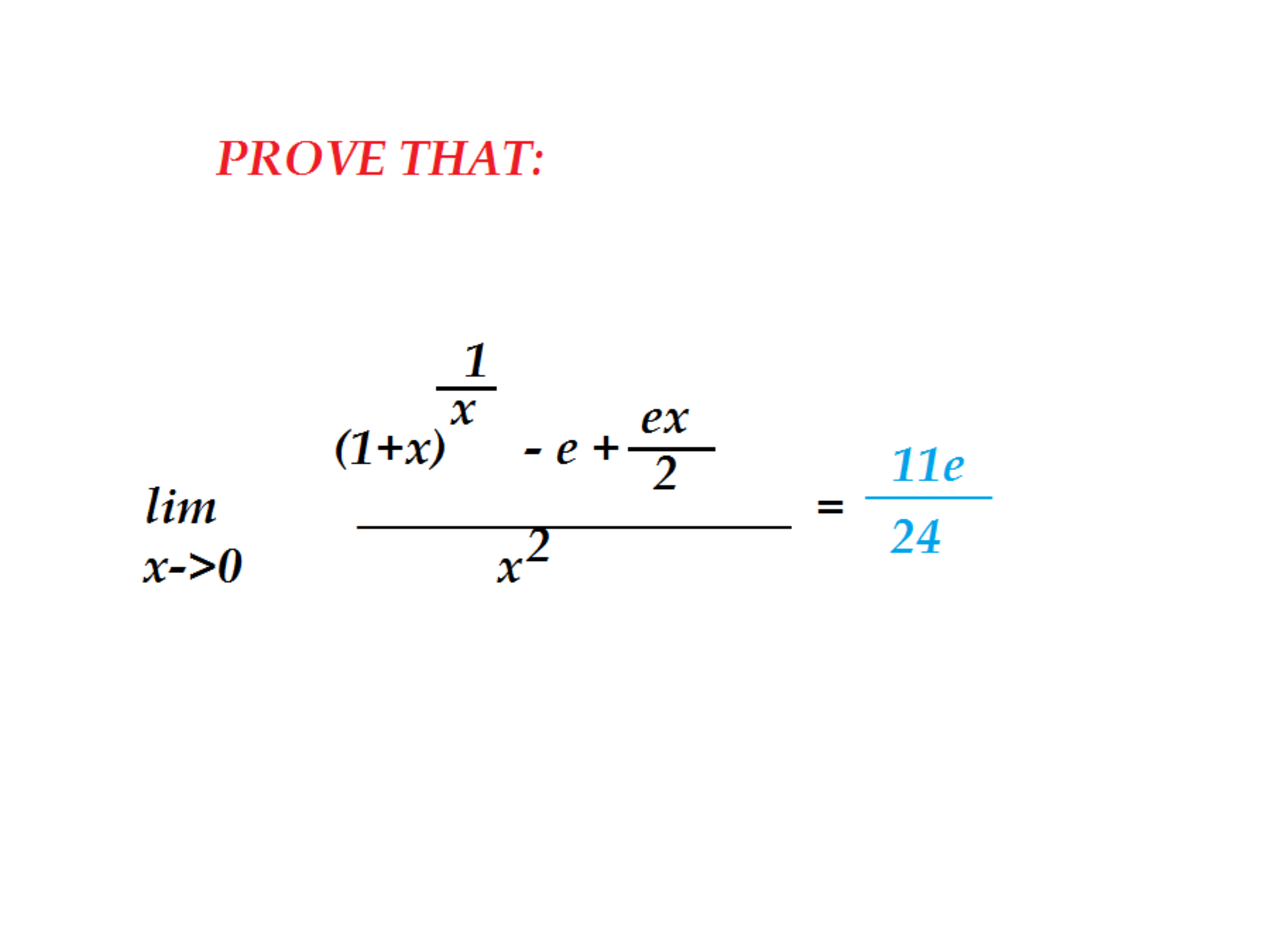Solve this limit problem

Please prove this limit problem and please solve it step by step...Thanks in advance...
No vote yet
2 votes

Please prove this limit problem and please solve it step by step...Thanks in advance...
Easy Math Editor
This discussion board is a place to discuss our Daily Challenges and the math and science related to those challenges. Explanations are more than just a solution — they should explain the steps and thinking strategies that you used to obtain the solution. Comments should further the discussion of math and science.
When posting on Brilliant:
*italics*or_italics_**bold**or__bold__paragraph 1
paragraph 2
[example link](https://brilliant.org)> This is a quote# I indented these lines # 4 spaces, and now they show # up as a code block. print "hello world"\(...\)or\[...\]to ensure proper formatting.2 \times 32^{34}a_{i-1}\frac{2}{3}\sqrt{2}\sum_{i=1}^3\sin \theta\boxed{123}Comments
The trick is to state (1+x)x1 in terms of its Maclaurin Series (up to quadratic powers, because the denominator is a quadratic power as well).
Recall that the Maclaurin Series of f(x) is k=0∑∞k!fk(0)xk, where fk(0) denote the kth derivative of f(x) at x=0, with that we get ln(1+x)=x−2x2+3x3−4x4+…. And apply the quotient rule: if f(x)=v(x)u(x), then f′(x)=[v(x)]2v(x)u′(x)−u(x)v′(x)
Then for small x, ln(1+x)≈x−2x2+3x3, (∗)
Let f(x)=(1+x)x1, we get f(0)=x→0lim(1+x)x1=e
⇒lnf(x)=xln(1+x)
⇒f(x)f′(x)=x21+xx−ln(1+x)=x2(1+x)x−(1+x) ln(1+x)
For small x, substitute (∗)
⇒f(x)f′(x)=x2(1+x)x−(1+x) (x−2x2+3x3)
⇒f(x)f′(x)=6x+6−2x2+x−3, (∗∗)
⇒f′(0)=f(0)⋅6−3=−2e, (∗∗∗)
Differentiate (∗∗):
[f(x)]2f(x)f′′(x)−[f′(x)]2=−3x2+6x+3x2+2x−2
⇒[f(0)]2f(0)f′′(0)−[f′(0)]2=32
⇒e2e⋅f′′(0)−[−2e]2=32
⇒f′′(0)=1211e, (∗∗∗∗)
Therefore, for small x, (1+x)x1=f(x)=k=0∑∞k!fk(0)xk
⇒(1+x)x1=e−2ex+2411ex2+O(x3)
Now we can evaluate the limit
x→0limx2(1+x)x1−e+2ex
=x→0lim2x22(1+x)x1−2e+ex
=x→0lim2x22(e−2ex+2411ex2+O(x3))−2e+ex
=x→0lim2x21211ex2+O(x3)
=x→0lim21211e+O(x)
=2411e
Log in to reply
Amazing! Great job Pi Han!
How you format these equations in solutions? Can we use latex?
Thanks you a lot...Great job it is....U r seemingly the master hand of limit problems...Thanks.
Here is another method :
x→0limx2(1+x)x1−e+2ex
= x→0limx2exln(1+x)−e+2ex
= x→0limx2e(exln(1+x)−1−1+2x)
= x→0limx2e(ex(x−2x2+3x3−…)−1−1+2x)
= x→0limx2e(e(−2x+3x2−…)−1+2x)
= x→0limx2e(1+(−2x+3x2−…)+2(−2x+3x2−…)2+⋯−1+2x)
x→0limx2e(3x2+8x2+…) = 2411e
write (1+x)^(1/x)=e^(1/x)log(1+x) and expand carefully by neglecting all the terms greater than x^2, you can get it